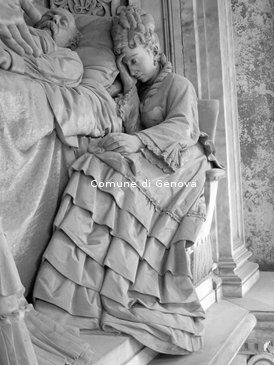This tomb represents the relatives’ sorrow while they are gathered around Carlo’s deathbed, the old head of the household. Also his son Edilio, a well-known ship owner and industrialist, holds a wake over his dead father. Edilio is represented while standing and comforting his mother, even if his look is turned to his father’s deathbed, near which also his brother Armando is standing. In this case, the process of “concretization” of the lamentation for the deceased – which had been preannounced by the sculptor Giovanni Battista Cevasco through Pietro Gàmbaro’s tomb – is now fully accomplished: the consequence is a representation of “death itself”, in an indoor bourgeois setting where there are no symbolic figures, neither comforting or accompanying angels. The bourgeois Realism proves to be the most appropriate style to express this new idea of death: the sculptor Rivalta makes use of a kind of analytical descriptivism which leads to a representation of even the smallest details of the furniture, the clothes and the decorations, and conveys the characters’ emotions to the viewer. It was no accident that his career, which had started in Genoa, has continued in Florence by the Macchiaioli’s side, who used to paint some similar scenes taken from the “actual” life.



